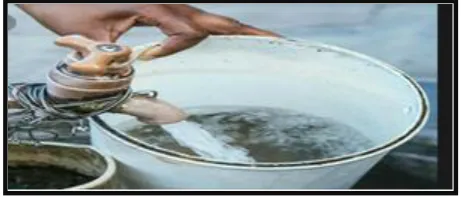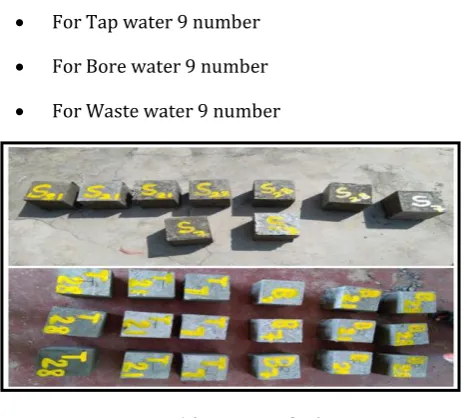© 2019, IRJET | Impact Factor value: 7.211 | ISO 9001:2008 Certified Journal
| Page 4880
Effect of Different Types of Water on Compressive Strength of Concrete
Vijay Basanagouda Doddagoudara
1, Santhosha. B. Doddagowdra
2, Prashant sunagar
3,
Channabasava Bellad
4,
Poornima. K. B
5, Dr. Shivakumara B
61
Vijay Basanagouda Doddagoudara, Student, Dept of civil Engineering
2Santhosha.B.Doddagowdra Student, Dept of civil Engineering
3
Prashant Sunagar, Student, Dept of civil Engineering
4Channabasava Bellad, Student, Dept of civil Engineering
5
Poornima.K.B
,
Professor, Dept. of Civil Engineering, S. T. J. Institution of technology, Karnataka, India
6Dr. Shivakumara B, Principal, Dept. of Civil Engineering, S. T. J. Institution of technology, Karnataka, India
---***---Abstract - The study centered on the effect of differentqualities of water on concrete compressive strength. The concrete mix of M20 grade with water cement ratio of 0.5 was investigated. Water samples, such as tap water, sewage water, bore well water, were collected from Ranebennur city and were used to cast 150mm concrete cubes. The cured cubes were crushed on 7,21 & 28 days for compressive strength estimation. The results showed that the compressive strength of the concrete cubes made with tap water, bore well water, sewage water increased with days & not having much variation in their compressive strength.
Key Words: Concrete; compressive strength; water;
qualities sewage water; bore water; tap water.
1. INTRODUCTION
If the waste water is utilized for some other domestic purposes it leads to a lot of human illness in their study haven given the impact of this problem in detail. To minimize these problems the waste water can be used for construction work without affecting the surrounding environment. By utilization of this water, water scarcity can be reduced. Cement generally represents 12-14% of concrete weight. It plays an active part in the mixture. During the hardening process, it generates shrinkage and heat dissipation phenomena which lead to material cracking. Water is an important ingredient of concrete as it actively participates in the chemical reaction with cement. Since it helps to form the strength giving cement gel, the quantity and quality of water is required to be looked into very carefully. It has been discussed enough about the quantity of mixing water but so far the quality of water has not been discussed. In practice, very often great control on properties of cement and aggregate is exercised but the control on the quality of water is often neglected. Since quality of water affects the strength, it is necessary for us to go into the purity and quality of water. In the present work, the mix proportion is designed as per IS 10262 for M20 grade of concrete. As there are so many types of quality of water are available namely tap water, well water, bore well water, waste water etc. all these types of water were used for making the concrete cubes, specimen of size 150mm × 150mm × 150mm
as per Indian standard were tested at 7 days 21 days and 28 days to find out compressive strength.
2.ADVANTAGES ANDOBJECTIVES
1. Using of waste water for making concrete reduces the load on water treatment process, by avoiding the primary treatment processes screening, settling, aeration and others.
2. By comparing compressive test results, we can analyse how different types of water affect’s the strength of the concrete.
3. Water samples are easily available.
2.1 Objectives
1. To study the physico chemical characteristics of tap water, bore well water and waste water, for making concrete cubes.
2. To design and analyse the effect of different types of water on compressive strength of concrete. 3. To reduce the load on treatment plant.
4. To analyse the effect of prepared concrete cubes on the environment.
3. MATERIALS AND METHODOLOGY
STUDY AREA
© 2019, IRJET | Impact Factor value: 7.211 | ISO 9001:2008 Certified Journal
| Page 4881
3.01 .Qualities of water for making concrete. (mixingwater for concrete)
Tap water bore, well water and sewage water. Tap water (running water, city water, town water, municipal water, etc.) is water supplied to a tap (valve). Its uses include drinking, washing, cooking, and the flushing of toilets. Indoor tap water is distributed through "indoor plumbing", which has existed since antiquity but was available to very few people until the second half of the 19th century when it began to spread in popularity in what are now developed countries. Tap water became common in many regions during the 20th century, and is now lacking mainly among people in poverty, especially in developing countries.
Fig. 1 (Tap water)
A bore well water is an excavation or structure created in the ground by digging, driving, and or drilling to access groundwater in underground aquifers. The well water is drawn by a pump, or using containers, such as buckets, that are raised mechanically or by hand.
Fig. 2( bore well)
Sewage water (or waste water) is any water that has been affected by human use. Wastewater is "used water from any combination of domestic, commercial or agricultural activities, surface runoff or storm water, and any sewer inflow or sewer infiltration". Therefore, wastewater is a by-product of domestic, commercial or agricultural activities. The characteristics of wastewater vary depending on the source. Types of wastewater include: domestic wastewater from households, municipal wastewater from communities (also called sewage) or industrial wastewater from industrial activities. Wastewater can contain physical, chemical and biological pollutants.
Fig. 3 (Sewage water)
3.02 Mixing
Concrete shall be mixed in a mechanical mixer. The mixer should comply with IS 1791 and IS 12119. The mixers shall be fitted with water measuring (metering) devices. The mixing shall be continued until there is a uniform distribution of the materials and the mass is uniform in color and consistency. If there is segregation after unloading from the mixer, the concrete should be remixed. We use hand mix.
[image:2.595.54.295.98.254.2] [image:2.595.322.543.251.398.2] [image:2.595.46.277.443.542.2]© 2019, IRJET | Impact Factor value: 7.211 | ISO 9001:2008 Certified Journal
| Page 4882
Fig. 4 (Mixing Concrete)3.03 Concrete cubes.
The concrete slump test measures the consistency of fresh concrete before it sets. It is performed to check the workability of freshly made concrete, and therefore the ease with which concrete flows. It can also be used as an indicator of an improperly mixed batch. The test is popular due to the simplicity of apparatus used and simple procedure.
All these types of water were used for making the concrete cubes, specimen of size 150mm × 150mm × 150mm as per Indian standard were tested at 7 ,21days and 28 days to find out compressive strength.
Number of Samples are collected for curing the Concrete Cubes
Total number of cubes are 27
For Tap water 9 number
For Bore water 9 number
For Waste water 9 number
Fig. 5 (concrete cubes)
3.04 Experimental set up of concrete compression test
This Compression testing Machine (Fig.6) was used on the seven day, and twenty eight day cured concrete specimens. For each test day, the cubes were placed in the loading
apparatus, and the load was actuated at a controlled loading rate. Once the specimen reached its critical load, one of the load indicators needle recorded the exact failure point.
Fig. 6(Compression testing Machine)
[image:3.595.38.286.98.256.2]4. RESULT AND DISCUSSION
Table -1:
Test details Compressive strength of concrete Cubes.
Sample no. 1 2 3
Specimen Sewage
water Tap water Bore water
Date of
Casting 11/01/2019 31/01/2019 31/01/2019
No of sample prepared
9 9 9
Table -2:
For 7 days compressive strength of cube size 150*150*150mm
Type of water
Compressi ve strength
(tone)
Compressi ve
Strength
(N/mm2)
Average compressi ve strength
(N/mm2)
Cubes tested date
Sewag
e 32 13.9 14.08 18/01/19
[image:3.595.314.552.144.341.2] [image:3.595.39.562.400.800.2] [image:3.595.46.280.476.685.2]© 2019, IRJET | Impact Factor value: 7.211 | ISO 9001:2008 Certified Journal
| Page 4883
water 32.5 14.17Tap
water 44.5 19.4 20.83 08/02/19
49 21.3
50 21.8
Bore
water 46 20.056 19.54 08/02/19
42.5 18.53
46 20.056
[image:4.595.216.553.54.257.2]The above graph shows the variation of 7days compressive strength of different types of water samples, 7days compressive strength for M20 Grade 13.5N/MM.
Table -3:
For 21 days compressive strength of cube size 150*150*150mm
Type of water
Compressi ve strength (tone)
Compressi ve Strength (N/mm2)
Average compressi ve strength (N/mm2)
Cubes tested date
Sewag e water
39 17.1 16.8 01/02/
19
38 16.5
39 17
Tap
water 55 64 23.98 27.94 28.049 22/02/19
74 32.264
Bore
water 50 52 21.8 22.672 22.8 22/02/19
55 23.98
[image:4.595.29.557.59.462.2]The above graph shows the variation of 21 days compressive strength of different types of water samples, 21 days compressive strength for M20 Grade
Table -4:
For 28 days compressive strength of cube size 150*150*150mm
Type of water
Compressi ve strength
(tone)
Compressi ve
Strength
(N/mm2)
Average compressi ve strength
(N/mm2)
Cubes tested date
Sewag e water
43 18.75 18.9 08/02/
19
44 19.2
43 18.75
Tap
water 59 25.92 23.8 01/03/19
50 21.8
55 23.98
Bore
water 63 27.4 25.6 01/03/19
56 24.4
© 2019, IRJET | Impact Factor value: 7.211 | ISO 9001:2008 Certified Journal
| Page 4884
The above graph shows the variation of 28 days compressivestrength of different types of water samples, 28 days compressive strength for M20 Grade 20N/MM.
5. CONCLUSIONS
1)Sewage water, tap water, bore water etc. have 7, 21 and 28 day compressive strength equal to or at least 90 present the results shows that concrete made with different qualities of water samples such as of the strength of reference specimens made with different types of water for M20 grade of concrete.
2) From the analysis of test carried out, it was revealed that, the concrete made with questionable water sample.
i.e. sewage water sample with a constant water – cement ratio of 0.5, there was about 8.30% more 7- day compressive strength and 5.5% less for 28 days compared to reference specimen
3) The compressive strength obtained for concrete made with tap water has more strength than the cubes made with sewage water.
4) The concrete made with sewage water having slightly less 28 - day compressive strength, compared to 7 days compressive strength.
5) The bore water compressive strength is more for 28 days as compared to tap and sewage water samples.
6) Also, sewage waters from cities can’t be used as mixing waters for concrete.
REFERENCES
[1]. Al-Manaseer, A.A., Haug, M.D. &Naseer, K.W.(1988) Compressive Strength of concrete containing fly ash, brine and admixture, American Concrete Institute Material Journal, 85(2): 109-116.
[2]. Akinkurolere et.al. (2007). “The influence of salt water on the compressive and engineering and applied science.2007; 2(2); 412-415.
[3]. Cement Concrete & Aggregates Australia. “Use of Recycled Water in Concrete Production” August 2007.
[4]. Donald F. Griffin and Robert L. Henry “The effect of salt in concrete on compressive strength, water vapour transmission, and corrosion of reinforcing steel”
Y-R007-05-01 -012.
[5]. I.S. 10262-2009: Recommended guidelines for concrete mix design. Bureau of Indian Standards, NewDelhi.
[6]. I.S. 456: 2000 Code of practice for plain and reinforce concrete Bureau of Indian Standards, New Delhi. (Third revision).
[7]. Islam-Ul-Haque*, M A Baig and Mohsin Mir “ Use of Municipal waste water for plain cement concrete construction” Electronic journal of Environmental, Agricultureal & Food Chemistry, ISSN : 1579-4377.
[8]. Omotola Alawode, P. G. Dip, and O.I. Idowu M. Sc. “ Effect of water- cement ratios on the compressive strength & workability of concrete & lateritic concrete mixes”.MC Bauchemie (Ind) Pvt. Ltd.
[9]. M.S. Shetty Technical Advisor, MC Bauchemie (Ind) Pvt. Ltd. “ Concrete Technology. Theory & Practice”.
[10]. P. Saravanakumar and G. Dhinakaran. “Effect of acidic water on strength, durability & corrosion of concrete”. Journal of Civil Engineering Research & Practice, Vol. 7 No. 2, October 2010.
BIOGRAPHIES
Vijay Basanagouda Doddagoudara Student
Dept.of civil engineering, S.T.J.I.T college, Ranebennur. Karnataka, India
Santhosha.B.Doddagowdra Student
© 2019, IRJET | Impact Factor value: 7.211 | ISO 9001:2008 Certified Journal
| Page 4885
Prashant sunagarStudent
Dept.of civil engineering, S.T.J.I.T college, Ranebennur. Karnataka, India
Channabasava Bellad Student
Dept.of civil engineering, S.T.J.I.T college, Ranebennur. Karnataka, India
Poornima.K.B Professor
Dept.of civil engineering, S.T.J.I.T college, Ranebennur. Karnataka, India
Dr. Shivakumara B. Principal


